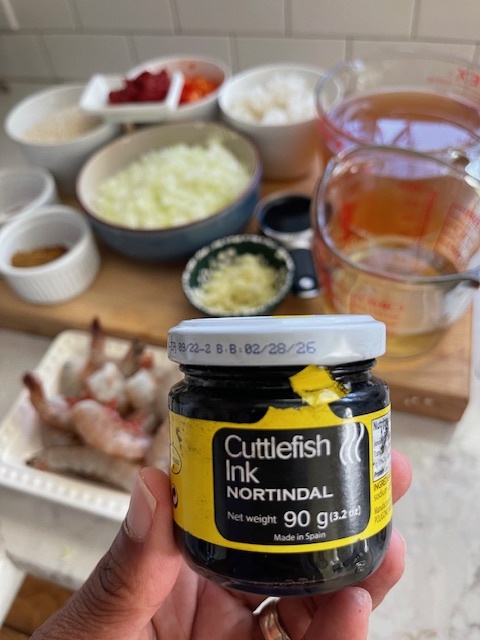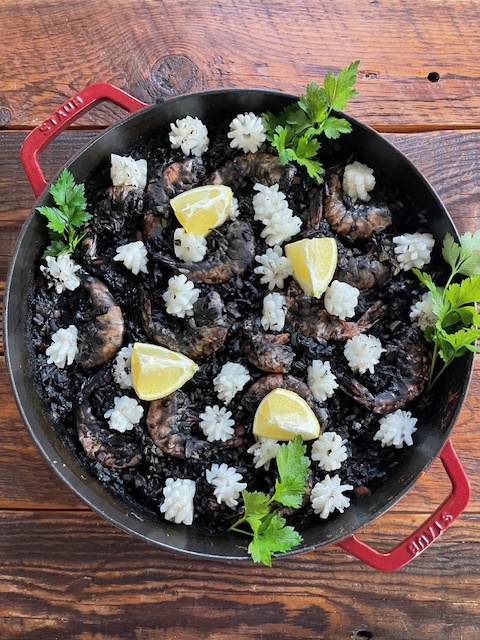Recently, I received four media sample wines from Spain, each hailing from a distinct and renowned region: Rueda, Rías Baixas, Rioja, and Sherry. Inspired by this diverse selection, I decided to prepare one of my favorite classic Spanish dishes, Paella Negra, to explore how well it would pair with each of these exciting wines.. In this post, I’ll share my tasting journey and explore how these wines complement the deep, savory notes of homemade Paella Negra. Whether you’re a seasoned wine enthusiast or just beginning your journey, these pairings are sure to add a delicious twist to your next meal.
A Journey Through Spain’s Wine Regions
Spain is a country with a rich viticultural heritage, offering a diverse range of wines that reflect the unique terroir of each region. From the lush, green landscapes of Galicia to the sun-drenched vineyards of Andalusia, Spain’s wine regions are as varied as the wines they produce. Each of the four regions featured in this post—Rueda, Rías Baixas, Rioja, and Sherry—has its own distinct identity, shaped by its geography, climate, and grape varieties.
- Rueda is located in the heart of Castilla y León, in northwestern Spain. Known primarily for its white wines, Rueda’s rolling vineyards are situated on a high plateau with a continental climate that features hot summers and cold winters. The region is renowned for the Verdejo grape, which produces wines with bright acidity, citrus, and herbaceous notes.
- Rías Baixas is situated along the rugged Atlantic coast in Galicia, in the far northwest of Spain. This region’s cool, maritime climate is perfect for producing fresh, zesty white wines. The Albariño grape is the star here, yielding wines with high acidity, vibrant citrus, and a touch of minerality that reflects the ocean breeze.
- Rioja is one of Spain’s most famous wine regions, located in the north-central part of the country. Rioja is divided into three sub-regions: Rioja Alta, Rioja Alavesa, and Rioja Oriental. Each of these sub-regions has a slightly different climate, from the cooler, higher-altitude vineyards of Rioja Alta to the warmer, drier Rioja Oriental. Tempranillo is the primary grape of Rioja, known for producing red wines with flavors of dark berries, plum, and a characteristic vanilla and spice from oak aging.
- Sherry comes from the Jerez region in Andalusia, in the sunny south of Spain. This region is famous for its fortified wines, which are produced using a unique aging process that involves a combination of biological and oxidative aging. Palomino is the primary grape used in the production of dry Sherry, such as Fino and Manzanilla, while Pedro Ximénez and Moscatel are used for the sweeter styles.
Disclosure: Wines were provided as a media samples. No other compensation was received. All opinions are mine.
Paella Negra
Paella Negra, also known as Arroz Negro, is a traditional Spanish dish that hails from the coastal regions of Valencia and Catalonia. It is a variation of the classic paella, distinguished by its deep black color, which comes from squid or cuttlefish ink used in the preparation. The dish typically includes a combination of seafood such as squid, shrimp, and clams, cooked with rice, garlic, onions, and a rich seafood broth. The squid ink not only gives the dish its striking color but also imparts a unique, briny depth of flavor that makes Paella Negra a beloved specialty in Spanish cuisine.


Mise en place! 
Paella Negra with Shrimp and Squid 
It was finger-licking good!
Tio Pepe Fino
Tasting Notes: Tío Pepe is an archetypal and best selling Fino in the world. González Byass was the first Sherry winery to export the fino style back in 1844 when they sent casks of this local style to the UK. Aged under flor for 4 years, it pours a very pale gold yellow color with lemon, bruised green apple, bread dough, green olive and saline aromas that remind me of salty ocean spray. On the palate it’s medium-bodied and dry, yet with ample green apple, lemon, almond and a hint of grapefruit flavors nicely accented with an appealing salinity. 15% abv|SRP – $19.99
Pairing with Paella Negra: A dry Sherry like Fino or Manzanilla pairs exceptionally well with Paella Negra. The wine’s saline quality mirrors the dish’s briny essence. It’s mouthwatering acidity and nutty undertones add an extra layer of complexity to the meal. Grade: A
2023 Pazo de Lusco Albariño
Tasting Notes: The wine pour a lemon yellow color with lemon curd, fresh bread dough, nectarine, honeydew and subtle ocean spray aromas. On the palate it’s medium-bodied with zesty, mouthwatering acidity and honeydew, fresh ripe nectarine, lemon zest and lemon curd flavors with a very appealing saline minerality. 12.5% abv|SRP – $24.99
Pairing with Paella Negra: The bright acidity and citrusy character of an Albariño from Rías Baixas make it a natural partner for Paella Negra. The wine’s freshness lifts the dish, while its subtle salinity echoes the seafood elements. Albariño’s fruitiness can also balance the dish’s richness, creating a most harmonious pairing. Grade: A+
2023 Beronia Rueda
Tasting Notes: The wine pours a pale lemon color with enticing aromas of lime, melon, white peach and coriander. On the palate, it’s light bodied and very fresh with lime zest, white peach, melon and red grapefruit pith with an appetizing bit of bitterness. 13% abv| SRP – $13.99
Pairing with Paella Negra: The acidity and citrus notes of a Rueda Verdejo beautifully complement the rich, umami flavors of Paella Negra. The wine’s crispness cuts through the dish’s savory depth, enhancing the seafood elements while refreshing the palate. Grade: A
2020 Beronia Crianza
Tasting Notes: Translucent garnet with inviting sour cherry, cured meat, cigar box, dried herb and dark roast coffee aromas. On the palate, it’s medium-bodied with vibrant acidity and velvety, sweet tannins with sour cherry, dried red cherry, raspberry, vanilla, mocha and baking spice flavors 14% abv|SRP – $14.99
Pairing with Paella Negra: While Rioja is traditionally paired with meats, I think it can also complement Paella Negra. The wine’s robust flavors stand up to the intense umami of the dish, with the oak influence adding a layer of spice that enhances the squid ink’s depth. I felt the pairing achieved a “peaceful co-existence” mainly because the richness of the squid ink (which I might use less of next time) slightly overshadowed the wine. However, my wife found it to be a very good match. I think it would be interesting to try this dish with a Reserva or Gran Reserva, as the additional aging might bring a new dimension to the pairing. Grade: B-
These wines are all part of the Gonzalez Byass USA portfolio. They range from very good to excellent, delivering superb quality for the price!
Exploring wines from Sherry, Rías Baixas. Rueda, and Rioja offered a delightful journey through Spain’s diverse wine landscape. Each region brings something unique to the table, and when paired with Paella Negra, these wines showcase the brilliance of Spanish cuisine and viniculture. Whether you prefer the zesty freshness of Rueda, the complexity of Sherry, the depth of Rioja, or the vibrancy of Rías Baixas, there’s a perfect wine for every palate and a perfect pairing for this iconic Spanish dish.
Cheers to discovering the tastes of Spain!
I’m uber picky about paella and this looks absolutely amazing! We recently had a Beronia and agree that it offers excellent QPR. Gracias por la recomendaciones!
Thanks for the kind words. Paella Negra is definitely a favorite of ours, but this was our first time making it at home. Delicious stuff, but next time I’d use less squid ink (a little goes a long way – and it’s rich) Salud!